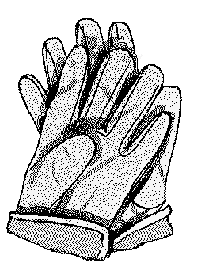
AIEL MARKET
Purchase Guide
WORK GLOVES


Hand protection may not seem like much, but it's important for
those that want to keep on working. Rough, dry hands are not
conducive to maximum work, and in a touring situation where
it's non-stop for sometimes months, hand care is important.
THE FOLLOWING MAY NOT BE REPRODUCED
WITHOUT PERMISSION FROM THE AUTHOR ©
Work gloves may seem trivial but they of course, protect one's hands when loading equipment. They can also afford thermal protection in cold climates during a long load-in or out. Buying a good pair of gloves will assure proper fit and a good grip on the gear. Given the cost of equipment, this is important to your employer, and every thing you do is scrutinized. Dropping an expensive moving light is not likely to get you a place on the next tour's crew.
One might think that any work glove will do, but there are gloves for different industries and they are designed to grip/carry different types of items. Thick gloves that are internally re-enforced with wire mesh are used in the sheet metal industry. Thin, but thermally-strong gloves are used in the outdoor construction industry to allow unhindered work, but to protect against cold temperatures. Other gloves have rubber nubs or faces to allow carrying of slippery items such as sheet and plate glass, and so on.
For the entertainment industry, one should have a strong pair of canvas/leather gloves with good stitching and long cuffs. Gloves with double stitching are recommended for this purpose. These allow the carrying of heavy objects without stresses tearing the gloves apart. Long cuffs give wrist protection when carrying cases with recessed "rung" handles that are typically found on speaker cabinets. Long glove cuffs prevent chaffing where the wrist contacts the cabinet above the handle. They can also afford some protection to wrist watches, which shouldn't really be worn during this type of work, anyway.
Materials suggested are a good-quality canvas or denim glove with leather facing. Most cheap gloves give out due to seam tearing, but the second most likely reason is that the palm has worn to a point where the glove fails to protect. This exposes the substrate which is slippery compared to the leather facing. Realise though, that an all-leather work glove is advised against because they are typically too stiff. A canvas/denim glove allows better flexibility, while leather facing affords protection, extra strength, a safer grip, and it contributes to a longer-lived glove.
For lighting work, a lighter, but thermally insulated type is recommended. Rubber palms and finger facings are a good option. One can grip a hot light to pan/tilt it and lock the fixture in place with minimal discomfort. These glove types use a lighter woven cloth with a grip coating. They won't last as long as the heavy canvas types but do offer protection and dexterous capability in one package. I use a pair of Therma-Fit gloves with rubber palms and fingers. These do insulate my hands from hot lights when I am doing a focus, but have become my favourite gloves for a variety of other tasks, as well. Don't go the cheap route. There are dollar-store versions of these but they don't last at all. I pay $10 a pair for the ones I use; they're well worth the extra cost.
One should be aware of fit. Do not buy a loose-fitting glove. It can cause one to expend some energy just to keep the glove on the hand. Some come with wrist straps. These are fine and do allow one to tighten a glove at least at the wrist. However, they do not make up for a loose fit around the hand. A glove which slides during carrying is not suitable. If you prefer the wrist-strap type, stay away from velcro straps. They are often good initially, but once they get dirty, they fail to hold, and you'll find yourself wearing a loose glove with flapping straps. Instead, get the buckle or snap type of wrist strap - and ones that can be adjusted.
Try the glove on for size, fit, grip, and comfort. If possible, lift something heavy while wearing it. Check to see that the material is thick enough, is double-stitched, and has good-quality leather palm and finger facing. If selected for lighter duty work such as light hanging and focusing, assure that your fingers remain dexterous when inside the gloves, and look for some thermal protection.
Pay a good price; dollar-store gloves are not for professionals. They typically disintegrate long before the end of a tour and rarely fit well to begin.
A nice pair of work gloves makes loading and unloading of
equipment, and the hanging and focusing of lights a little
less of a chore. A great pair can add pleasure to a usually
otherwise unenjoyable necessity of the touring industry.
This Article is
Available in
Plain Text for
Your Archives
Work Gloves Guide, Text Format
|
Return to |
Return to the |
Go to the |